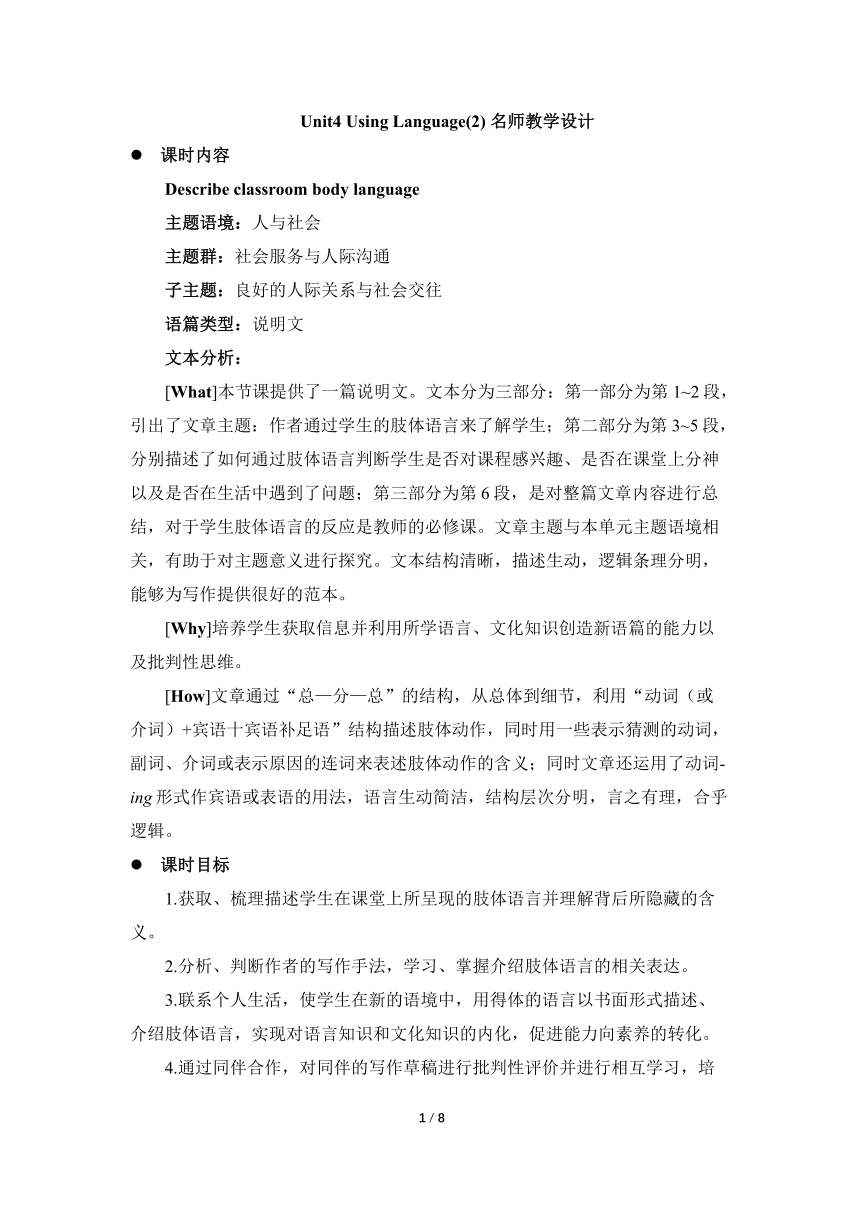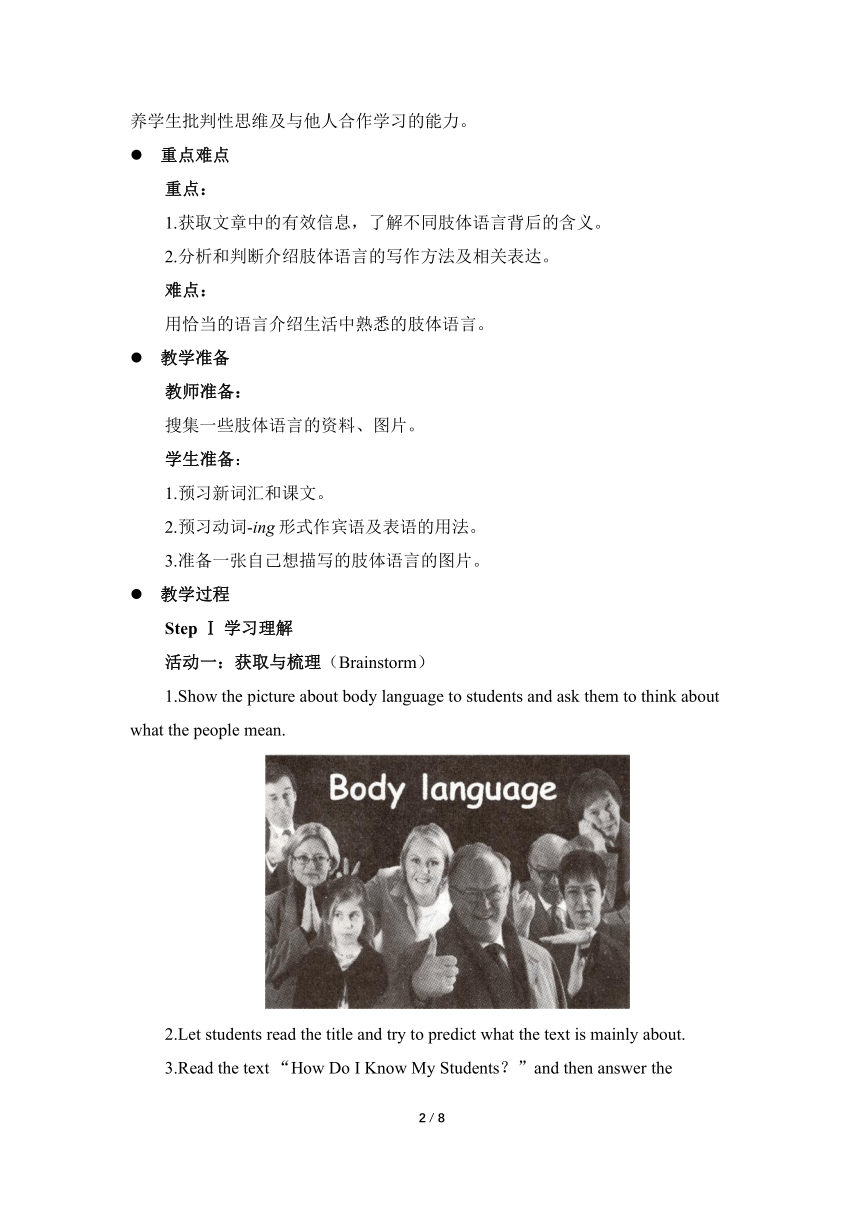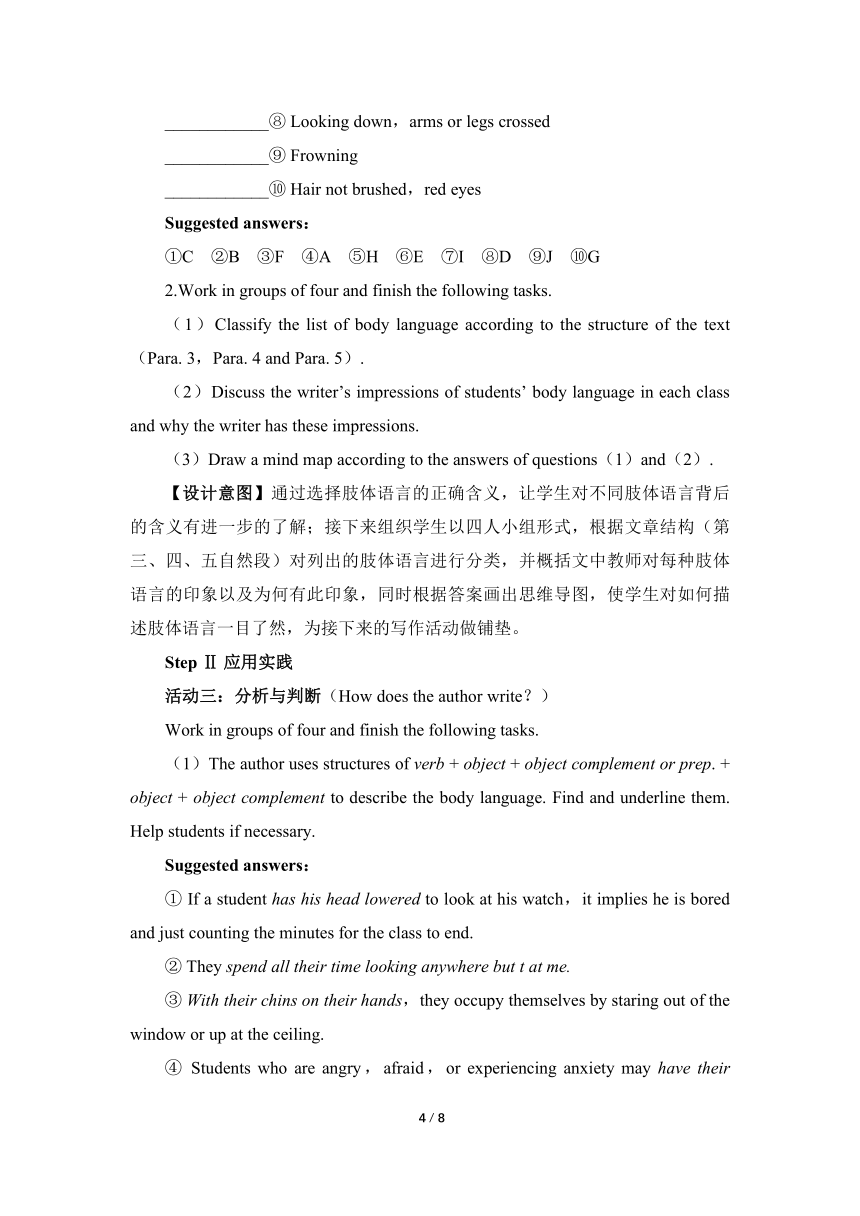人教版(2019)选择性必修 第一册Unit 4 Body Language Using Language(2) 名师教学设计
文档属性
| 名称 | 人教版(2019)选择性必修 第一册Unit 4 Body Language Using Language(2) 名师教学设计 |  | |
| 格式 | docx | ||
| 文件大小 | 798.9KB | ||
| 资源类型 | 教案 | ||
| 版本资源 | 人教版(2019) | ||
| 科目 | 英语 | ||
| 更新时间 | 2023-03-11 20:44:54 | ||
图片预览




文档简介
Unit4 Using Language(2) 名师教学设计
课时内容
Describe classroom body language
主题语境:人与社会
主题群:社会服务与人际沟通
子主题:良好的人际关系与社会交往
语篇类型:说明文
文本分析:
[What]本节课提供了一篇说明文。文本分为三部分:第一部分为第1~2段,引出了文章主题:作者通过学生的肢体语言来了解学生;第二部分为第3~5段,分别描述了如何通过肢体语言判断学生是否对课程感兴趣、是否在课堂上分神以及是否在生活中遇到了问题;第三部分为第6段,是对整篇文章内容进行总结,对于学生肢体语言的反应是教师的必修课。文章主题与本单元主题语境相关,有助于对主题意义进行探究。文本结构清晰,描述生动,逻辑条理分明,能够为写作提供很好的范本。
[Why]培养学生获取信息并利用所学语言、文化知识创造新语篇的能力以及批判性思维。
[How]文章通过“总—分—总”的结构,从总体到细节,利用“动词(或介词)+宾语十宾语补足语”结构描述肢体动作,同时用一些表示猜测的动词,副词、介词或表示原因的连词来表述肢体动作的含义;同时文章还运用了动词-ing形式作宾语或表语的用法,语言生动简洁,结构层次分明,言之有理,合乎逻辑。
课时目标
1.获取、梳理描述学生在课堂上所呈现的肢体语言并理解背后所隐藏的含义。
2.分析、判断作者的写作手法,学习、掌握介绍肢体语言的相关表达。
3.联系个人生活,使学生在新的语境中,用得体的语言以书面形式描述、介绍肢体语言,实现对语言知识和文化知识的内化,促进能力向素养的转化。
4.通过同伴合作,对同伴的写作草稿进行批判性评价并进行相互学习,培养学生批判性思维及与他人合作学习的能力。
重点难点
重点:
1.获取文章中的有效信息,了解不同肢体语言背后的含义。
2.分析和判断介绍肢体语言的写作方法及相关表达。
难点:
用恰当的语言介绍生活中熟悉的肢体语言。
教学准备
教师准备:
搜集一些肢体语言的资料、图片。
学生准备:
1.预习新词汇和课文。
2.预习动词-ing形式作宾语及表语的用法。
3.准备一张自己想描写的肢体语言的图片。
教学过程
Step Ⅰ 学习理解
活动一:获取与梳理(Brainstorm)
1.Show the picture about body language to students and ask them to think about what the people mean.
2.Let students read the title and try to predict what the text is mainly about.
3.Read the text “How Do I Know My Students?”and then answer the following questions on Page 43.
·How does the teacher know what students are thinking?
·According to the teacher,what is some students’ favourite activity?
·What does the phrase “who knows what ”mean?
·Why does the teacher think body language is important?
Suggested answers:
·By looking at their body language.
·Daydreaming.
·It is impossible to tell(what they are interested in).
·Students’ body language lets the teacher know when to adjust class activities,when to intervene,and when to talk to students individually,so they can all get the most out of school.
【设计意图】通过观察图片和猜测标题的含义,引导学生对一些常见的肢体语言进行思考,找出其背后隐藏的含义,使其提前进入话题,为接下来的文章阅读做好准备。通过回答间题,帮助学生理解课文内容,掌握其中细节。
活动二:概括与整合(Generalisation and mind-mapping)
1.Match the body language with the meanings. Write the letters A~J on the lines.
A very interested B bored C interested D sad or worried E distracted F writing notes G serious problems H like they are asleep I daydreaming J angry,afraid,or experiencing anxiety
____________① Looking up and making eye contact
____________② Leaning over to look at one’s watch
____________③ Two friends leaning heads together
____________④ Leaning forward and looking at the teacher
____________⑤ Looking up,but no eye contact,no expression
____________⑥ Looking away
____________⑦ Chin on hand,looking out the window
____________⑧ Looking down,arms or legs crossed
____________⑨ Frowning
____________⑩ Hair not brushed,red eyes
Suggested answers:
①C ②B ③F ④A ⑤H ⑥E ⑦I ⑧D ⑨J ⑩G
2.Work in groups of four and finish the following tasks.
(1)Classify the list of body language according to the structure of the text (Para. 3,Para. 4 and Para. 5).
(2)Discuss the writer’s impressions of students’ body language in each class and why the writer has these impressions.
(3)Draw a mind map according to the answers of questions(1)and(2).
【设计意图】通过选择肢体语言的正确含义,让学生对不同肢体语言背后的含义有进一步的了解;接下来组织学生以四人小组形式,根据文章结构(第三、四、五自然段)对列出的肢体语言进行分类,并概括文中教师对每种肢体语言的印象以及为何有此印象,同时根据答案画出思维导图,使学生对如何描述肢体语言一目了然,为接下来的写作活动做铺垫。
Step Ⅱ 应用实践
活动三:分析与判断(How does the author write?)
Work in groups of four and finish the following tasks.
(1)The author uses structures of verb + object + object complement or prep. + object + object complement to describe the body language. Find and underline them. Help students if necessary.
Suggested answers:
① If a student has his head lowered to look at his watch,it implies he is bored and just counting the minutes for the class to end.
② They spend all their time looking anywhere but t at me.
③ With their chins on their hands,they occupy themselves by staring out of the window or up at the ceiling.
④ Students who are angry,afraid,or experiencing anxiety may have their arms crossed in front of their chests and their legs closed or crossed,like they are guarding their bodies.
(2)Find the verbs,adverbs,prepositions or conjunctions used in the text to explain the meaning of the body language,and underline the sentences. Help students if necessary.
Suggested answers:
Verbs:
If a student…,it implies he…
If a student…,then I can infer that…
Adverbs:
If two friends…,they are probably…
Prepositions:
They…like…
Conjunctions:
Some students act this way merely because…
(3)There are also some -ing forms used as object and predicative in the text. Can you find them?
Suggested answers:
-ing form used as object:
Some students act this way merely because they are afraid of being called on by the teacher.
-ing form used as predicative:
Then again,some students’ favourite activity is daydreaming.
The main thing is reminding distracted students that they need to pay attention in class.
Ultimately,my duty is helping every student to learn.
【设计意图】通过写作手法学习(①用“动词/介词十宾语+宾语补足语”的结构来描述肢体语言;②用表示猜测的动词,副词、介词及表示原因的连词来解释肢体语言的含义;③用动词-ing形式作宾语或表语的用法来为文章添色),使学生对文章语用知识方面有更深层次的理解,也为下一步的写作活动打好语言基础。
活动四:内化与应用(Write your introduction to body language)
1.Look at the following photos. In groups,use what you’ve learnt above to discuss what these people are doing and what their body language is telling you.
① ② ③
Suggested answers:
① It looks like the teacher is pointing at a male student,who is looking up with a serious expression on his face. I think the teacher is scolding him for something. Meanwhile,the girl in the back of the photo is hiding her mouth with her hand,and from her eyes it looks like she is smiling. Perhaps she is happy that the other student is being scolded.
② The boy is giving a fist pump and smiling. This is normally done when someone has just accomplished something good and wants to celebrate.
③ The boy is telling a joke to the girl in secret,and she is hiding her face because she is laughing.
2.Ask students to bring out the picture they drew before the class in which there is someone they all know and show his/her body language in the picture.
3.Ask students to write a passage to describe the body language of the person in their drawing,and explain what his/her body language tells us.
【设计意图】本活动为写作实践,在写作前设计小组活动,引导学生用之前所学语言知识口述图片中人物的肢体语言及含义,使学生先有所实践再动笔书写,旨在降低写作难度,增强写作的信心。
Step Ⅲ 迁移创新
活动五:批判与评价
Ask students to exchange their draft with a partner.
(1)Use the checklist to help them review their partner’s draft.
√ Is the person properly identified?
√ Is the description clear?
√ Does the writer give his/her impressions of the feelings and personality of the person in the drawing,and also explain why he/she has these impressions?
√ Does the writer use any structures of verb + object + object complement or prep.+ object + object complement to describe the body language?
√ Does the writer use any verbs,adverbs,prepositions or conjunctions learnt in class to explain the meaning of the body language?
√ Are there any -ing forms used as object or predicative
√ Does the writer use correct grammar,punctuation,and spelling?
(2)Ask students to take their draft back and revise it.
(3)Ask students to share their essay with the rest of the class.
【设计意图】通过同伴合作,让学生探讨文章是否能清楚地反映出所描写的人物,对肢体语言的描写是否清晰,作者是否给出自己对图片中人物的性格的感受及印象并对其做出解释,是否使用“动词/介词十宾语十宾语补足语”的结构来描述肢体语言,是否使用课上所学动词、副词、介词及连词来解释肢体语言的含义,是否使用动词 -ing 形式作宾语或表语,文章语法、标点、词汇拼写是否正确,从而使学生对同伴的草稿进行综合评价并进行相互学习,加深对主题意义的理解和批判思维及多元思维的培养,实现深度学习。
板书设计
Unit 4 Body Language Period Ⅴ Using Language (2) Ⅰ.学习理解 活动一:获取与梳理(Brainstorm) 活动二:概括与整合(Generalisation and mind-mapping) Ⅱ.应用实践 活动三:分析与判断(How does the author write?) 活动四:内化与应用(Write your introduction to body language) Ⅲ.迁移创新 活动五:批判与评价
2 / 2
课时内容
Describe classroom body language
主题语境:人与社会
主题群:社会服务与人际沟通
子主题:良好的人际关系与社会交往
语篇类型:说明文
文本分析:
[What]本节课提供了一篇说明文。文本分为三部分:第一部分为第1~2段,引出了文章主题:作者通过学生的肢体语言来了解学生;第二部分为第3~5段,分别描述了如何通过肢体语言判断学生是否对课程感兴趣、是否在课堂上分神以及是否在生活中遇到了问题;第三部分为第6段,是对整篇文章内容进行总结,对于学生肢体语言的反应是教师的必修课。文章主题与本单元主题语境相关,有助于对主题意义进行探究。文本结构清晰,描述生动,逻辑条理分明,能够为写作提供很好的范本。
[Why]培养学生获取信息并利用所学语言、文化知识创造新语篇的能力以及批判性思维。
[How]文章通过“总—分—总”的结构,从总体到细节,利用“动词(或介词)+宾语十宾语补足语”结构描述肢体动作,同时用一些表示猜测的动词,副词、介词或表示原因的连词来表述肢体动作的含义;同时文章还运用了动词-ing形式作宾语或表语的用法,语言生动简洁,结构层次分明,言之有理,合乎逻辑。
课时目标
1.获取、梳理描述学生在课堂上所呈现的肢体语言并理解背后所隐藏的含义。
2.分析、判断作者的写作手法,学习、掌握介绍肢体语言的相关表达。
3.联系个人生活,使学生在新的语境中,用得体的语言以书面形式描述、介绍肢体语言,实现对语言知识和文化知识的内化,促进能力向素养的转化。
4.通过同伴合作,对同伴的写作草稿进行批判性评价并进行相互学习,培养学生批判性思维及与他人合作学习的能力。
重点难点
重点:
1.获取文章中的有效信息,了解不同肢体语言背后的含义。
2.分析和判断介绍肢体语言的写作方法及相关表达。
难点:
用恰当的语言介绍生活中熟悉的肢体语言。
教学准备
教师准备:
搜集一些肢体语言的资料、图片。
学生准备:
1.预习新词汇和课文。
2.预习动词-ing形式作宾语及表语的用法。
3.准备一张自己想描写的肢体语言的图片。
教学过程
Step Ⅰ 学习理解
活动一:获取与梳理(Brainstorm)
1.Show the picture about body language to students and ask them to think about what the people mean.
2.Let students read the title and try to predict what the text is mainly about.
3.Read the text “How Do I Know My Students?”and then answer the following questions on Page 43.
·How does the teacher know what students are thinking?
·According to the teacher,what is some students’ favourite activity?
·What does the phrase “who knows what ”mean?
·Why does the teacher think body language is important?
Suggested answers:
·By looking at their body language.
·Daydreaming.
·It is impossible to tell(what they are interested in).
·Students’ body language lets the teacher know when to adjust class activities,when to intervene,and when to talk to students individually,so they can all get the most out of school.
【设计意图】通过观察图片和猜测标题的含义,引导学生对一些常见的肢体语言进行思考,找出其背后隐藏的含义,使其提前进入话题,为接下来的文章阅读做好准备。通过回答间题,帮助学生理解课文内容,掌握其中细节。
活动二:概括与整合(Generalisation and mind-mapping)
1.Match the body language with the meanings. Write the letters A~J on the lines.
A very interested B bored C interested D sad or worried E distracted F writing notes G serious problems H like they are asleep I daydreaming J angry,afraid,or experiencing anxiety
____________① Looking up and making eye contact
____________② Leaning over to look at one’s watch
____________③ Two friends leaning heads together
____________④ Leaning forward and looking at the teacher
____________⑤ Looking up,but no eye contact,no expression
____________⑥ Looking away
____________⑦ Chin on hand,looking out the window
____________⑧ Looking down,arms or legs crossed
____________⑨ Frowning
____________⑩ Hair not brushed,red eyes
Suggested answers:
①C ②B ③F ④A ⑤H ⑥E ⑦I ⑧D ⑨J ⑩G
2.Work in groups of four and finish the following tasks.
(1)Classify the list of body language according to the structure of the text (Para. 3,Para. 4 and Para. 5).
(2)Discuss the writer’s impressions of students’ body language in each class and why the writer has these impressions.
(3)Draw a mind map according to the answers of questions(1)and(2).
【设计意图】通过选择肢体语言的正确含义,让学生对不同肢体语言背后的含义有进一步的了解;接下来组织学生以四人小组形式,根据文章结构(第三、四、五自然段)对列出的肢体语言进行分类,并概括文中教师对每种肢体语言的印象以及为何有此印象,同时根据答案画出思维导图,使学生对如何描述肢体语言一目了然,为接下来的写作活动做铺垫。
Step Ⅱ 应用实践
活动三:分析与判断(How does the author write?)
Work in groups of four and finish the following tasks.
(1)The author uses structures of verb + object + object complement or prep. + object + object complement to describe the body language. Find and underline them. Help students if necessary.
Suggested answers:
① If a student has his head lowered to look at his watch,it implies he is bored and just counting the minutes for the class to end.
② They spend all their time looking anywhere but t at me.
③ With their chins on their hands,they occupy themselves by staring out of the window or up at the ceiling.
④ Students who are angry,afraid,or experiencing anxiety may have their arms crossed in front of their chests and their legs closed or crossed,like they are guarding their bodies.
(2)Find the verbs,adverbs,prepositions or conjunctions used in the text to explain the meaning of the body language,and underline the sentences. Help students if necessary.
Suggested answers:
Verbs:
If a student…,it implies he…
If a student…,then I can infer that…
Adverbs:
If two friends…,they are probably…
Prepositions:
They…like…
Conjunctions:
Some students act this way merely because…
(3)There are also some -ing forms used as object and predicative in the text. Can you find them?
Suggested answers:
-ing form used as object:
Some students act this way merely because they are afraid of being called on by the teacher.
-ing form used as predicative:
Then again,some students’ favourite activity is daydreaming.
The main thing is reminding distracted students that they need to pay attention in class.
Ultimately,my duty is helping every student to learn.
【设计意图】通过写作手法学习(①用“动词/介词十宾语+宾语补足语”的结构来描述肢体语言;②用表示猜测的动词,副词、介词及表示原因的连词来解释肢体语言的含义;③用动词-ing形式作宾语或表语的用法来为文章添色),使学生对文章语用知识方面有更深层次的理解,也为下一步的写作活动打好语言基础。
活动四:内化与应用(Write your introduction to body language)
1.Look at the following photos. In groups,use what you’ve learnt above to discuss what these people are doing and what their body language is telling you.
① ② ③
Suggested answers:
① It looks like the teacher is pointing at a male student,who is looking up with a serious expression on his face. I think the teacher is scolding him for something. Meanwhile,the girl in the back of the photo is hiding her mouth with her hand,and from her eyes it looks like she is smiling. Perhaps she is happy that the other student is being scolded.
② The boy is giving a fist pump and smiling. This is normally done when someone has just accomplished something good and wants to celebrate.
③ The boy is telling a joke to the girl in secret,and she is hiding her face because she is laughing.
2.Ask students to bring out the picture they drew before the class in which there is someone they all know and show his/her body language in the picture.
3.Ask students to write a passage to describe the body language of the person in their drawing,and explain what his/her body language tells us.
【设计意图】本活动为写作实践,在写作前设计小组活动,引导学生用之前所学语言知识口述图片中人物的肢体语言及含义,使学生先有所实践再动笔书写,旨在降低写作难度,增强写作的信心。
Step Ⅲ 迁移创新
活动五:批判与评价
Ask students to exchange their draft with a partner.
(1)Use the checklist to help them review their partner’s draft.
√ Is the person properly identified?
√ Is the description clear?
√ Does the writer give his/her impressions of the feelings and personality of the person in the drawing,and also explain why he/she has these impressions?
√ Does the writer use any structures of verb + object + object complement or prep.+ object + object complement to describe the body language?
√ Does the writer use any verbs,adverbs,prepositions or conjunctions learnt in class to explain the meaning of the body language?
√ Are there any -ing forms used as object or predicative
√ Does the writer use correct grammar,punctuation,and spelling?
(2)Ask students to take their draft back and revise it.
(3)Ask students to share their essay with the rest of the class.
【设计意图】通过同伴合作,让学生探讨文章是否能清楚地反映出所描写的人物,对肢体语言的描写是否清晰,作者是否给出自己对图片中人物的性格的感受及印象并对其做出解释,是否使用“动词/介词十宾语十宾语补足语”的结构来描述肢体语言,是否使用课上所学动词、副词、介词及连词来解释肢体语言的含义,是否使用动词 -ing 形式作宾语或表语,文章语法、标点、词汇拼写是否正确,从而使学生对同伴的草稿进行综合评价并进行相互学习,加深对主题意义的理解和批判思维及多元思维的培养,实现深度学习。
板书设计
Unit 4 Body Language Period Ⅴ Using Language (2) Ⅰ.学习理解 活动一:获取与梳理(Brainstorm) 活动二:概括与整合(Generalisation and mind-mapping) Ⅱ.应用实践 活动三:分析与判断(How does the author write?) 活动四:内化与应用(Write your introduction to body language) Ⅲ.迁移创新 活动五:批判与评价
2 / 2
